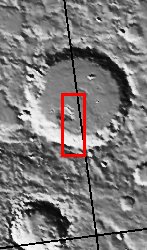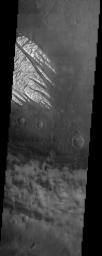- Original Caption Released with Image:
-

(Released 19 April 2002)
The Science
"White Rock" is the unofficial name for this unusual landform which was first observed during the Mariner 9 mission in the early 1970's. As later analysis of additional data sets would show, White Rock is neither white nor dense rock. Its apparent brightness arises from the fact that the material surrounding it is so dark. Images from the Mars Global Surveyor MOC camera revealed dark sand dunes surrounding White Rock and on the floor of the troughs within it. Some of these dunes are just apparent in the THEMIS image. Although there was speculation that the material composing White Rock could be salts from an ancient dry lakebed, spectral data from the MGS TES instrument did not support this claim. Instead, the White Rock deposit may be the erosional remnant of a previously more continuous occurrence of air fall sediments, either volcanic ash or windblown dust. The THEMIS image offers new evidence for the idea that the original deposit covered a larger area. Approximately 10 kilometers to the southeast of the main deposit are some tiny knobs of similarly bright material preserved on the floor of a small crater. Given that the eolian erosion of the main White Rock deposit has produced isolated knobs at its edges, it is reasonable to suspect that the more distant outliers are the remnants of a once continuous deposit that stretched at least to this location. The fact that so little remains of the larger deposit suggests that the material is very easily eroded and simply blows away.
The Story
Fingers of hard, white rock seem to jut out like icy daggers across a moody Martian surface, but appearances can be deceiving. These bright, jagged features are neither white, nor icy, nor even hard and rocky!
So what are they, and why are they so different from the surrounding terrain?
Scientists know that you can't always trust what your eyes see alone. You have to use other kinds of science instruments to measure things that our eyes can't see . . . things like information about what kinds of minerals make up the landforms. Mars scientists once thought, for instance, that these unusual features might be vast hills of salt, the dried up remains of a long-ago, evaporated lake.
Not so, said an instrument on the Mars Global Surveyor spacecraft, which revealed that the bright material is probably made up of volcanic ash or windblown dust instead. And talk about a cyclical "ashes to ashes, dust to dust" story! Particles of this material fell and fell until they built up quite a sedimentary deposit, which was then only eroded away again by the wind over time, leaving the spiky terrain seen today. It looks white, but its apparent brightness arises from the fact that the surrounding material is so dark.
Of course, good eyesight always helps in understanding. A camera on Mars Global Surveyor with close-up capabilities revealed that sand dunes are responsible for the smudgy dark material in the bright sediment and around it. But that's not all. The THEMIS camera on the Mars Odyssey spacecraft that took this image reveals that this ashy or dusty deposit once covered a much larger area than it does today. Look yourself for two small dots of white material on the floor of a small crater nearby (center right in this image). They preserve a record that this bright deposit once reached much farther. Since so little of it remains, you can figure that the material probably isn't very hard, and simply blows away.
One thing's for sure. No one looking at this image could ever think that Mars is a boring place. With all of its bright and dark contrasts, this picture would be perfect for anyone who loves Ansel Adams and his black-and-white photography.
- Image Credit:
-
NASA/JPL/Arizona State University
Image Addition Date: -
2002-05-21
|

 Planetary Data System
Planetary Data System













